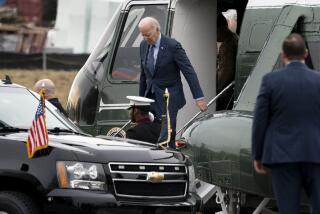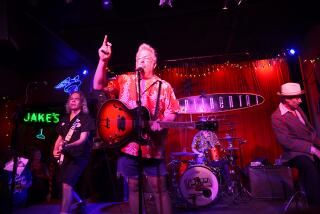A. Hutschnecker; Served as ‘Shrink’ to Richard Nixon
- Share via
‘It is safer for a politician to go
to a whorehouse than to see a psychiatrist.’
--Dr. Arnold Hutschnecker
*
The doctor was in a position to know. He was the only mental health professional known to have treated a man who became president. That president was Richard Milhous Nixon.
Arnold Hutschnecker, who died at 102 at his home in Sherman, Conn., on Dec. 28, began treating Nixon in the early 1950s, when Nixon was a U.S. senator from California. He saw Nixon several times in the ‘50s, and only sporadically after that, but did visit Nixon twice at the White House when he was president.
Always a workaholic, Nixon as a young legislator was experiencing back and neck pains brought on by the stress of the long days related to congressional hearings into the activities of Alger Hiss and then the tough 1950 Senate campaign against Helen Gahagan Douglas. He was looking for a medical answer.
A former colleague gave him a copy of “The Will to Live,” a popular self-help book by Hutschnecker, then an internist, that tracked the connection between conflict in the human psyche and physical complaints like insomnia, hypertension, impotence and chronic fatigue.
So in 1951, probably in the early fall, Nixon made a quick trip from Washington to New York and Hutschnecker’s office. According to press reports and the recent book “The Arrogance of Power: The Secret World of Richard Nixon” by Anthony Summers, Nixon saw Hutschnecker several times that year.
Nixon’s initial complaint had been of feeling “a little nervous, irritable and not sleeping so good,” the doctor recalled in one of several interviews he gave to Summers. “I gave him a mild sedative and told him to come back in two weeks.”
Finding No ‘Serious Psychiatric Diagnosis’
Nixon came back over the next few years--but by then he was Dwight D. Eisenhower’s vice president. Nixon arrived for his consultations, according to Summers, in an official limousine accompanied by Secret Service agents.
And while the doctor never did get Nixon to accept a full course of treatment, the two men developed a close relationship.
When Nixon called, said Hutschnecker, “He’d say, ‘Could we have breakfast?’ And I’d go. . . . He needed me. It was what we call a transference, a trust. He came to me when he had decisions to make. Or when something was pending and it troubled him.
“He didn’t have a serious psychiatric diagnosis,” Hutschnecker told Summers. “Nixon wasn’t psychotic. He had no pathology. But he did have a good portion of neurotic symptoms.”
Hutschnecker thought Nixon was “an emotionally deprived child,” who grew up to become a “person who regarded love and physical closeness as a diversity that would drain him, deplete him, make him less manly. Love . . . never had a priority in Nixon’s life, for he always convinced himself that he didn’t need to be loved as a human being, only respected as a man.”
Hutschnecker thought he was making progress with Nixon, and recalled that he visited the vice president at a New York hotel.
“I remember going to his suite,” the doctor told Summers, “and hearing him singing, so happy in the shower. And I said to myself, ‘Aha, my treatment is working.’ ”
But that treatment stopped suddenly for a time in 1955 when Hutschnecker switched his specialty from internal medicine to psychotherapy.
That fact, coupled with a snide comment about Nixon’s mental health in a column by the influential Walter Winchell, led the vice president to take his physical problems to a military doctor in Washington, D.C.
Hutschnecker always decried the stigma facing politicians who seek psychiatric treatment. After noting the safety of the brothel versus the psychiatrist’s couch, Hutschnecker added that “My unforgivable sin was not staying an internist. Then no one could say in the papers that the president was going to a shrink.”
He Publicly Called Adolf Hitler a Pig
The shrink was a product of the Old World, growing up in Berlin and graduating from Frederich Wilhelm University there in 1925. After reading “Mein Kampf,” he became a vocal critic of Adolf Hitler, often referring to the Nazi leader in public as a pig. Former patients of his who had joined the SS urged Hutschnecker to leave the country and he did so with his family in 1936, landing in New York.
He quickly set up a thriving medical practice and, by 1941, had moved into a suite of offices on Park Avenue. In the late 1940s, his interest turned to psychosomatic illness and depression. He remained an internist, however, treating a number of celebrity patients, reportedly including actresses Rita Hayworth and Elizabeth Taylor and the writer Erich Marie Remarque.
A short, dapper man, Hutschnecker was once described in a Washington Post story as having “a touch of the missionary zeal of Billy Graham, the cheery optimism of Norman Vincent Peale, the psychic beliefs of a Jeanne Dixon, and an accent a bit reminiscent of Peter Sellers as Dr. Strangelove.”
Nixon renewed his relationship with Hutschnecker in the late 1950s, summoning the doctor to his office in Washington, meeting with him during the presidential race against John F. Kennedy and then again in early 1961 just before Kennedy took office.
In 1962, Nixon saw Hutschnecker again and, according to Summers, “ignored the doctor’s advice not to run” for governor of California.
In an article for Look magazine in 1969, “The Mental Health of Our Leaders,” Hutschnecker called Nixon’s famously bitter encounter with the press after losing the race (“You won’t have Nixon to kick around anymore.”) a “subjective reaction to a personal traumatic experience”--that of a man seeing his political career in shambles.
Hutschnecker maintained in that article that he saw Nixon in his role as an internist and that “during the entire period that I treated Mr. Nixon, I detected no sign of mental illness in him.”
For his part, Nixon always scoffed publicly at the notion that psychiatry would be any sort of help.
“People go through that psychological bit nowadays,” he told a reporter in 1966. “They think they should always be reevaluating themselves. . . . That sort of juvenile self-analysis is something I’ve never done.”
During his successful campaign for the White House in 1968, Nixon’s aides persuaded their boss to sever his relationship with the doctor to avoid adverse publicity. However, it is known that Nixon was visited by Hutschnecker twice at the White House. The two men also maintained contact by telephone.
On one of those visits, in December 1969, Nixon apparently asked Hutschnecker to study the report of the National Commission on the Causes and Prevention of Violence and make some recommendations.
One of the doctor’s suggestions, that 6- to 8-year-olds be tested for potential criminal behavior tendencies, was coupled with a suggestion that “the severely disturbed, the young hard-core criminal” be placed in treatment camps.
Quickly attacked as smacking of fascism, the idea was rejected by what was then the Department of Health, Education and Welfare.
Hutschnecker later maintained that the suggestion was distorted in the media. The camps he was recommending, he said years later in a letter to the New York Times, were modeled after summer camps he worked in when he came to America. The press, he said, saw the word camps and thought prison camps.
Despite the public furor over the idea, Nixon and Hutschnecker apparently remained in contact. But, according to the Summers book, Hutschnecker did not see Nixon during the Watergate scandal and could not account for the president’s behavior at that time.
After Nixon’s resignation, Hutschnecker said he visited the former president in San Clemente. Apparently believing that he would outlive the doctor, Nixon agreed to let the doctor write about their relationship.
Hutschnecker, the man Nixon turned to when faced with difficult decisions, last saw the former president in 1993, when he accompanied the Nixon family to the funeral of Nixon’s wife, Pat. At Nixon’s request, Hutschnecker sat in the area allotted to the family.
When his most famous client died a year later, Hutschnecker declined to go to the funeral because, as he told a reporter, “there was no one left . . . to help.”
More to Read
Sign up for Essential California
The most important California stories and recommendations in your inbox every morning.
You may occasionally receive promotional content from the Los Angeles Times.













